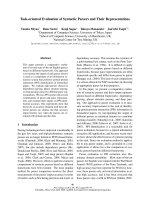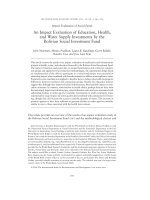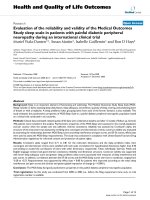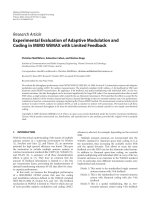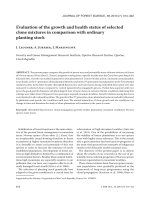Field evaluation of tuberose cultivars and symptom manifestation caused by foliar nematode, Aphelenchoides besseyi in tuberose
Bạn đang xem bản rút gọn của tài liệu. Xem và tải ngay bản đầy đủ của tài liệu tại đây (232.16 KB, 7 trang )
Int.J.Curr.Microbiol.App.Sci (2018) 7(3): 1364-1370
International Journal of Current Microbiology and Applied Sciences
ISSN: 2319-7706 Volume 7 Number 03 (2018)
Journal homepage:
Original Research Article
/>
Field Evaluation of Tuberose Cultivars and Symptom Manifestation
Caused by Foliar Nematode, Aphelenchoides besseyi in Tuberose
Suvash Chandra Bala* and Nihal Ravindranath
Department of Agricultural Entomology attach with AINP on Agril. Acarology, Bidhan
Chandra Krishi Viswavidyalaya, Mohanpur, West Bengal, India
*Corresponding author
ABSTRACT
Keywords
Tuberose, Cultivars,
Screening, Foliar
nematode, Symptom
manifestation
Article Info
Accepted:
12 February 2018
Available Online:
10 March 2018
Fourteen tuberose (Polianthes tuberose L) cultivars were evaluated under filed condition
to understand their performance against foliar nematode (Aphelenchoides besseyi Christie).
Significant differences were recorded among the tested cultivars for their yield attributing
parameters as well as nematode population in flower samples. However, the height stalk
length obtained from the cultivar Sikkim Selection while maximum spike length was
recorded from Prajwal (33.79 cm). The cultivar Vaibhav was recorded maximum number
of florets per spike (26.45) and maximum percentage of infestation was estimated in
cultivar GKTC Hyderabad (79.48%) followed by Single Hyderabad (79.48%) and Bidhan
Rajani-III (78.65%). However, minimum number of nematode population was registrant
the cultivar Phule Rajani and Prajwal respectively. Symptom appearance in tuberose due to
profuse feeding on the stalk epidermis as a result stalk became irregular and rugged, spiny
structures of variable number were found on the surface of the flower stalk along the
length. Sometimes spike developed but the florets did not bloomed or partial bloomed of
either lower most or the top most few florets. In few cases the flower stalk emerged with a
blind flower head where no spike developed.
Introduction
Tuberose (Polianthes tuberose) is the bulbous
ornamental plant; its value is high in respect of
artistic world for its beautification and
fragrance and occupies a very unique position
in flower loving people by virtue of sweet
pleasant and attractiveness. Due to dual
demand, it is currently cultivated in most of
the tropical and subtropical countries of the
world. It is commercially cultivated in many
countries of world like Hawaii, China, Brazil,
Italy, Iran, U.K., USA and India. In India,
commercial cultivation of tuberose is mainly
confined to the state of West Bengal,
Karnataka, Tamil Nadu, Maharastra, Orissa,
Assam, Uttar Pradesh. The foliar nematodes
Aphelenchoides besseyi Christie has been
identified as a key pest to this crop and posing
a serious threat to the tuberose cultivations all
over the country (Khan and Pal, 2001). This
nematode first time recorded from Hawaii
Island (Holtzmann, 1968) and in consequential
time it was reported form Ranaghat region of
Nadia district in West Bengal (Chakraborti
and Ghosh, 1993). In India, this nematode was
first reported by Dastur (1936) on rice. This
1364
Int.J.Curr.Microbiol.App.Sci (2018) 7(3): 1364-1370
nematode can cause yield losses upto 59% in
tuberose (Pathak and Khan 2009). Presence of
foliar nematode (Aphelenchoides besseyi) in
the flower stalk is main hindrance to export in
foreign countries. However, Different
management options have been recommended
for controlling of foliar nematode problem
(Chakraborti and Dutta, 1997, Chakraborti,
1995, Khan et al., 2005, and Cuc et al., 2010)
in tuberose. Though, few fungicides,
insecticides and botanical products have been
tested against foliar nematode (Chakraborti
and Ghosh, 1993, Chakraborti 1995,
Chakraborti and Dutta, 1997, Khan and
Ghosh, 2011) but none of the management
strategies provided promising against the
threat of foliar nematode in tuberose. Hence,
several cultivars had been evaluated under
filed condition to know the performance
against foliar nematode that caused flower
malady in tuberose.
Materials and Methods
This present experiments were conducted
during 2015-2017 at Net house condition,
Directorate of Research Building, Kalyani
(22059’18.89”N and 88027’10.14’E, 10 m
above MSL) to screen different tuberose
cultivar (Polianthes tuberosa L.) on the basis
of nematode infestation in flower. Fourteen
cultivars of tuberose namely, Prajwal,
Vaibhav, Phule Rajani, Shringar, Subhashini,
Bidhan Rajani-1, Bidhan Rajani-2, Bidhan
Rajani-3, Arka Nirantara, GKTC Hybrid,
Single Hyderabad, Hyderabad Double, Sikkim
Selection, and Calcuta Single were taken
for screening purpose. The experiment was
design in Randomized block having three
replications. The experimental field was
divided into forty two plots, measuring
2.0X2.0 m2. Bulbs of tuberose cultivars were
collected from AICRP on Floriculture project,
Directorate of Research, BCKV, Kalyani.
Collected bulbs was washed thoroughly and
soaked in plain water for overnight and planed
in field as per treatment schedule. Agronomic
practices adopted as per recommendations for
the cultivar of the crop in the region. The yield
attributing parameters of the crop viz., stalk
length, spike length, number of florets per
spike, percentage of infested flower and
nematode population per 10g of flowers were
also noted. All the data presented here based
on 24 observations during the period of
experiment. Another experiment was done on
symptom manifestation and its progress in
tuberose due to infestation by the foliar
nematode. Here observation was taken day by
day by visual estimation regarding progress of
symptom. For recording nematodes from
flower samples, samples were chopped into
small pieces with the help of sharp knife, then
they were placed on wire-gauge fitted over a
Petriplate containing clean water in such a
manner that the bottom of the gauge remained
just in touch to the water. The wire gauge was
then covered by another Petridish to prevent
water loss from the assembly and kept
undisturbed for 12 hrs. Nematodes suspension
was then passed through 20 and 400 mesh
sieves serially and final population count was
taken with the help of multi-chambered
counting disc under stereoscopic binocular
microscope. All the data obtained were
statistical analysis by using MSTAT-C
computer software and significance of
treatments was considered at P=0.05% level.
Results and Discussion
Screening of tuberose cultivars against
foliar nematode (Aphelenchoides besseyi
Christie)
The experiments were conducted at the net
house situated near Directorate of Research
complex,
Bidhan
Chandra
Krishi
Viswavidyalaya, Kalyani, and Nadia. Total
fourteen cultivars were screened under field
condition. Observations taken from July 2015
to January 2017 on different yield attributing
1365
Int.J.Curr.Microbiol.App.Sci (2018) 7(3): 1364-1370
parameters like stalk length, spike length,
number of florets per spike, percentage of
infestation and population of foliar nematode
per 10 g of flowers. It is evident from the
perusal data presented in table 2 that stalk
length range from 59.38 to 124.91 cm but
maximum length was obtained from the
cultivar Sikkim selection (124.79 cm) which
was statistically at par with the cultivar
Prajwal, and Calcutta Single whereas
minimum stalk length was recorded in the
cultivar Bidhan Rajani –II followed by GKTC
Hybrid, Phule Rajani and Single Hybrid. The
next best stalk length recorded from the
cultivars Bidhan Rajani-III, Subhashini and
Vaibhav. These findings are in accordance
with the result of Sarita et al., 2017.
Observation on spike length have been
presented in table 2 where maximum spike
length was obtained in the cultivar Prajwal
(33.79 cm) which was statistically at par with
the cultivar Vaibhav, Subhashini, Bidhan
Rajani-I and the minimum spike length was
recorded in the cultivar Bidhan Rajani-II
(20.26 cm) followed by Calcutta Single,
Bidhan Rajani –III, Sikkim Selection and
Phule Rajani though they are statistically at
par with each other’s.
nematode in tuberose, it was revealed that the
maximum infestation was observed in cultivar
GKTC Hyderabad (79.48%) which was
statistically at par with Single Hyderabad
(79.48%) and Bidhan Rajani-III (78.65%)
whereas, minimum infestation was observed
in the cultivar Phule Rajani (25.57%) followed
by Prajwal (34.07%). Nematode population
per unit of flower sample is one of the
important considerations to evaluate the
cultivar of tuberose (Fig. 1).
However, it was revealed from the present
study that none of the cultivar were registrant
against foliar nematode infestation although
the cultivars Phule Rajani (59.16 nematode
per 10g flowers) and Prajwal (64.34 nematode
per 10g flowers) were found to least
susceptible to foliar nematode Aphelenchoides
besseyi. On the other hand, the cultivar GKTC
Hyderabad (365.47 nematode per 10g flowers)
Bidhan Rajani-III, Bidhan Rajani-I, Bidhan
Rajani-II and Double Hyderabad were most
susceptible to foliar nematode infestation.
Symptom manifestation and its progress in
tuberose due to infestation by the foliar
nematode
Regarding number of florets per spike ranged
from 12.24 to 26.45, but maximum number of
florets per spike was recorded in the cultivar
Vaibhav (26.45).
Symptom development in tuberose due to
foliar nematode and its progress were keenly
observed right from sprouting of the bulbs.
The symptoms were initially marked by
emergence of yellowish green or pale green
leaves.
Comparison among different cultivars for the
number of florets per spike revealed that
cultivar Prajwal and Single Hyderabad and
Subhashini are statistically at par with each
other and minimum number of florets per
spike was recorded from the cultivar Bidhan
Rajani-III (12.24) followed by Culcutta
Single. The finding is in confirmed with the
report of Gaurav et al., 2005 and
Krishnamoorthy, 2014. Concerning the
percentage of infested flower caused by foliar
This might be due to reduction in chlorophyll
contain of the leaves following nematode
infestation. The leaves as well as the flower
heads emerged out of the top portion of the
bulbs where from maximum number of
nematodes was recovered. The tiny organisms
while feeding entered in developing flower
head and also fed on the epidermal layer of the
newly formed stalk.
1366
Int.J.Curr.Microbiol.App.Sci (2018) 7(3): 1364-1370
Table.1 Comparison between healthy and foliar nematode infested flower stalk and their related parameters
Infested flower stalk
Stalk weight (gm)
Spike length (cm)
Spike weight (gm)
Individual floret weight
(gm)
Floret length (cm)
Weight of florets/ spike
Population of A besseyi
per spike
49.0
95.0
3.15
6.5
74.0
0.0
78.5
2.8
52.2
37.2
28.0
0.70
3.6
14.8
30250.0
2.
95.2
3.8
87.4
45.0
60.0
2.65
6.3
43.0
13.0
80.3
3.0
54.0
38.5
29.5
0.50
3.3
13.3
18510.0
3.
111.2
4.2
121.9
47.0
100.0
3.20
6.6
78.0
0.0
60.2
2.3
29.3
25.5
18.2
0.45
3.1
9.8
15362.0
4.
106.0
3.3
74.6
33.0
68.9
2.58
5.8
32.0
34.0
60.0
2.9
28.4
26.2
15.0
0.50
3.2
8.0
8890.0
5.
96.0
3.0
85.0
43.0
58.7
2.8
6.0
42.5
16.0
58.3
2.5
48.6
26.0
27.0
0.80
3.7
14.0
30369.0
6.
86.0
2.40
74.0
30.4
42.8
2.0
5.8
34.4
21.0
56.4
2.4
53.0
25.0
24.8
0.75
3.5
17.0
32560.0
7.
102.0
3.50
101.5
44.0
82.0
2.7
6.0
65.2
0.0
63.0
3.0
26.3
19.0
17.0
0.45
3.2
9.0
12826.0
8.
86.3
2.40
72.2
29.5
47.5
2.6
6.4
30.8
23.0
74.1
2.1
48.1
22.0
10.0
0.50
2.8
8.5
11763.0
9.
90.4
2.70
82.3
29.6
36.9
1.9
5.4
31.5
0.0
48.6
2.0
46.0
16.8
8.5
0.40
3.0
4.5
9970.0
10.
95.5
3.0
83.9
42.4
53.2
2.5
5.8
41.8
15.0
63.8
3.2
32.5
28.3
19.3
0.68
3.2
13.8
20314.0
1367
Stalk length (cm)
115.8
Population of A besseyi
per spike
Individual floret weight
(gm)
4.0
Weight of florets/ spike
Spike weight (gm)
108.3
Floret length (cm)
Spike length (cm)
1.
Stalk length (cm)
Stalk weight (gm)
Stalk circumference (cm)
Healthy flower stalk
Stalk circumference (cm)
Sl. No.
Int.J.Curr.Microbiol.App.Sci (2018) 7(3): 1364-1370
Table.2 Observation of different yield attributing parameters as well as nematode population in
flower samples in the year 2015-17
Name of the variety
Prajwal
Single Hyd
GKTC Hyd
Bidhan Rajani - III
Bidhan Rajani - I
Vaibhav
Arka nirantara
Bidhan Rajani - II
Subhashini
Shringar
Double(HYD)
Phule Rajani
Sikkim selection
Calcutta single
S. Em. ±
CD (0.05)
Stalk
length
(cm)
101.95
70.76
65.54
92.35
82.49
86.51
80.72
59.38
87.78
73.63
76.02
67.84
120.91
110.38
5.34
19.05
Spike
length (cm)
33.79
23.81
22.92
21.89
33.18
33.03
22.62
20.26
33.05
23.80
24.43
22.34
21.88
20.97
1.97
5.09
No. of
florets
per spike
21.16
21.68
16.90
12.24
19.75
26.45
20.08
19.87
21.65
19.56
17.72
14.81
17.54
13.53
0.27
0.82
%of
infested
flower
34.07
79.46
79.48
78.65
66.34
50.45
69.66
56.57
60.50
47.42
58.13
25.57
47.98
23.74
2.53
6.98
Fig.1 Screening of tuberose cultivars under field condition
1368
Nematode
population per
10 g flower
64.34
200.59
365.47
336.55
317.63
270.12
127.23
315.43
207.85
204.93
300.71
59.16
165.99
120.70
3.78
20.77
Int.J.Curr.Microbiol.App.Sci (2018) 7(3): 1364-1370
Due to their profuse feeding on the stalk
epidermis became irregular and rugged. Spiny
structures of variable number were found on
the surface of the flower stalk along the
length which with aging pricks on touch. In
comparison between the uninfected or healthy
plants and foliar nematode infested plants, the
severely infested stalks became stunted and
reduced in length and weight (Table 1). In
most of the cases length of spikes as well as
number of florets declined. Average weight of
the florets sharply decreased to almost ¼ of
the healthy one while the length of floret also
declined substantially (Table 1). Brownish
patches developed on flower stalk and on
florets, petals of the flower became thicker,
anther became black in colour. Degree of
infestation by the nematodes in terms of
development of spike and blooming of florets
was manifested differentially. Sometimes
spike developed but the florets did not bloom
whereas, development of apparently normal
spike with partial blooming of either lower
most or the top most few florets was also
recorded. In few cases the flower stalk
emerged with a blind flower head where no
spike developed. Market value of the flowers
greatly reduced due to wrinkling of flowers
and reduction of fragrance. Chakraborti and
Ghosh (1993) observed that the nematodes
invaded the flower bud ectoparasitically,
pierce the stigma as well as ovary before
anthesis resulted to crinkled flower. Hassan
(1999) recorded spiny structures and
brownish patches on the flower stalks. He
also found that sometimes flower stalks
became twisted and chlorosis occurred
followed by drying up of leaves and retarded
growth of tuberose plants. The present
investigations are confirmed with the findings
of above mentioned authors.
It can be concluded from the experiment that
out of 14 cultivars screened under new
alluvial zone of West Bengal, the cultivar
Prajwal performed best stalk length, spike
length, minimum percentage of flower
infestation and nematode population per unit
of flower followed by Vaibhav, Subhashini,
Bidhan Rajani-III, Bidhan Rajani-I. However,
this cultivar could be popularized among the
farmers in West Bengal condition.
Acknowledgement
The Authors are thankful to Professor Matiyar
Rahaman Khan, Principal Scientist, Division
of Nematology, ICAR, New Delhi, Professor
Ajoy Kr. Mukhopadhyay, Department of
Agricultural Entomology and Professor R.
Sadhukhan, Department of Genetic and Plant
Breeding,
Bidhan
Chandra
Krishi
Viswavidyalaya, Mohanpur, Nadia for their
kind supports and cooperation for completed
this studies.
References
Chakraborti, H. S., and Ghosh, S. C. 1993.
Studies on the floral malady
of Polianthes tuberosa L. in West
Bengal. J. Mycopath. Res. 31(2): 109115.
Chakraborti, H.S., 1995. Chemical control of
floral malady of Polianthes tuberosa L.,
Journal Mycopathological Research.
33(1): 25 -28.
Chakraborti, H.S., and Dutta, P. 1997.
Phytochemical control of floral malady
of Polianthes tuberosa L, Journal
Mycopathological Research. 35(2):111
- 113.
Chakraborti, H.S., and Ghosh, S.C. 1993.
Studies on the floral malady of
Polianthes tuberosa L., Journal of
Mycopathological Research, 33(1): 2528.
Cuc, N.T.T., Thanh Son, N., Trung, T. M.,
Trang, Nguyen van, Dang, L. M., and
Pilon, M. 2010. Hot water treatment
prevents
Aphelenchoides
besseyi
damage to Polianthes tuberosa crops in
1369
Int.J.Curr.Microbiol.App.Sci (2018) 7(3): 1364-1370
the Mekong Delta of Vietnam. Crop
Protection 30:1-4.
Dastur, J.F., 1936. A nematode disease of rice
in the central provinces. Proceeding of
the Indian Academy of Sciences. 4: 108
- 122.
Gaurav, S.B., Katwate, S.M., Singh, B.R.,
Kahade, D.S., Dhane, A.V. 2005.
Quantitative genetic studies in tuberose.
J. Orn. Hort. 9(2), 124-127.
Hasan, M.M. 1999. Study on namatode
associated with tuberose (Polianthes
tuberosa L.) in West Bengal. M.Sc.
thesis.
Bidhan
Chandra
Krishiviswavidyalaya.
Mohanpur,
Nadia.
Holtzman, O.V. 1968. A foliar disease of
tuberose causer by Aphelenehoides
beseyi. Plant Dis. Reptr. 52: 56.
Khan, M. R. Shit, S., Pal, A. K. and Biswas,
B. 2006. Management of foliar
nematode, Aphelenchoides
besseyi infecting tuberose in West
Bengal,
India. Indian
J.
Nematol. 36 (1): 44-47.
Khan, M.R., and Ghosh, S. 2007. Evaluation
of tuberose cultivars against foliar
nematode, Aphelenchoides
besseyi,
In: National Symposium on Nematology
in 21st Century: Emerging paradigms,
Nov, 22-23, 2007, Nematological
Society of India, held at Assam, India,
pp.77.
Khan, M.R., and Ghosh, S. 2011. Survival
and population dynamics of foliar
nematode, Aphelenchoides besseyi
infecting tuberose in West Bengal,
India. Indian Journal of Nematology 41:
47-51.
Khan, M.R., and Pal, A. K. 2001. Plant
parasitic nematodes associated with
tuberose (Polianthes tuberosa L.) in
West Bengal. Ann. Pl. Protec. Sci. 9 (2):
357-359.
Khan, M.R., Shit, S., Ghosh, S., Bala, S.C.,
Pal, A.K. and Biswas, B. 2005. Foliar
nematode
Aphelenchoides
besseyi
infecting tuberose in West Bengal,
India. Abstract of the 7th Indian
Agriculture science and farmer’s
Congress held on 12-20 Feb., 2005,
Organized by Bioved Research and
communication centre, Allahabad and
S.V.B.P. Souvernir and abstracts.
University
of
Agriculture
and
Technology, Meerut, India, pp. 32-33.
Krishnamoorthy, V. 2014. Assessment of
tuberose (Polianthes tuberose) varieties
for growth and yield characters. Asian J.
Hort, 9 (2), 515-517.
Pathak, B., and Khan, M.R. 2009. Yield loss
potential
of
foliar
nematode,
Aphelenchoides besseyi in tuberose.
Indian Journal of Nematology 39: 3840.
Sarita, D., Parul, P., Mamta, B., and Tanuja,
2017. Screening of suitable germplasm
of Tuberose (Polianthes tuberosa L.)
for mid Hill conditions of Garhwal
Himalaya. International Journal of
Agricultural Science and research.
Vol.7, 499-506.
How to cite this article:
Suvash Chandra Bala and Nihal Ravindranath. 2018. Field Evaluation of Tuberose Cultivars
and Symptom Manifestation Caused by Foliar Nematode, Aphelenchoides besseyi in Tuberose.
Int.J.Curr.Microbiol.App.Sci. 7(03): 1364-1370. doi: />
1370


